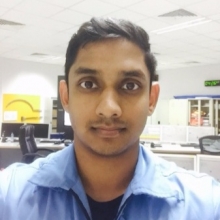
Dylan Gunatilake
Project Leader , ENGIE
Internet of Things
ENGIE places responsible growth at the core of its business lines (electricity, natural gas, energy services) to address the major challenges of energy transition to a low carbon economy: access to sustainable energy, mitigation and adaptation to climate change, and the rational use of resources. The Group develops high-performance, innovative solutions for individuals, cities, and businesses, building on its expertise in four key sectors: renewable energy, energy efficiency, liquefied natural gas and digital technologies. ENGIE has approximately 153,000 employees worldwide with revenue in 2016 of €66.6 billion.
ENGIE is implementing an ambitious digital transformation strategy that is vital to its plans to confront the major challenges posed by climate change and promote people’s access to reliable, innovative, socially responsible, low carbon, and decentralized energy.
ENGIE planned to invest €1.5 billion in new businesses and digital over the next three years with a significant portion committed to developing applications for AI and IoT use cases that are expected to profoundly transform its operations.
The breadth and scale of these use cases presented a unique problem: the solution should be flexible enough to serve Natural Gas Value Chain Metering, B2C Customer Engagement, Smart Cities, Renewables Predictive Maintenance use cases, and beyond; advanced enough to support state-of-the-art analytics and machine learning methods; and simple enough to allow ENGIE to quickly build up in-house capabilities to design, develop, and deploy these applications.
After a thorough review process, ENGIE selected C3 IoT as its strategic partner to provide the technology foundation for its enterprise-wide digital transformation. ENGIE and C3 IoT have initiated an aggressive roadmap leveraging C3 IoT’s high-performance, integrated, enterprise-scale IoT analytics and application development platform to deliver 28 apps across all of ENGIE’s 24 business units worldwide.
The first use case, Project DELTA, was launched into production in July 2017. A team composed of a dozen application developers, data engineers, and data scientists from both C3 IoT and ENGIE kicked off the project in January 2017 with this mission: to build an application that allows ENGIE’s plant operators to better understand the drivers of performance in gas-fired power plants. The development of the application - the first of its kind - was designed as a pilot focused initially on two CCGT plants located in Oman.
A data-first vision led to an approach that broadens the Digital Twin to encompass all business assets. Instead of taking a physics-based or rule-based approach to creating Digital Twins, ENGIE and C3 IoT integrated and aggregated data into a unified, federated cloud image. The companies then apply AI and machine learning to drive improved efficiency. Developers and data scientists are able to work on one platform enabling rapid innovation.
This approach allowed our data science team to virtually transport these assets to different geographies and apply varying inputs, essentially running virtual simulations to observe how these assets would react. We developed a set of features that answered critical questions for the plant:
- How to do “like for like” comparisons across assets and subassets, given the wide range of conditions at play. We solved with our advanced filtering & data explorer functionality.
- How to understand what is driving efficiency. We created composites of advanced machine learning algorithms/outputs that learn from datadriven behavior.
- How to identify the “true” degradation of key assets. We identified the real impact of time on efficiency and contrasted these curves with OEMset static curves.
Used in combination, these features go further than any other tool available to help performance engineers understand what drives efficiency and performance in their CCGT assets.
The project has been deployed successfully in the Middle East and is in the process of being deployed in Europe. Multiple valuable insights have been identified which translate into fuel optimizations driven by:
- Better anticipation of maintenance needs (e.g., the need to change a combustion chamber’s clogged air filter was flagged by Anomaly Detection)
- Tailored maintenance scheduling (e.g., prioritizing one Gas Turbine over the other based on degradation analysis)
- Adjustments of operational levers (e.g., running at high temperature differentials)
The unlocked value through these optimizations in the pilot phase has been evaluated at $300k per CCGT asset. This likely undervalues the true benefit of the application given the relatively young age of these assets and the impact of subsidized gas.
Extended to the entire installed fleet, fuel optimizations are estimated to total nearly $125-250M in aggregate; depending on gas prices and actionability.
The C3 IoT Platform allows rapid development of complex big data, predictive analytics and IoT applications. The C3 Type System, a data object-centric abstraction layer that binds all C3 IoT Platform components, significantly increases productivity by enabling app developers, data scientists, and business analysts to all work on the same framework. Project DELTA was developed entirely on the C3 IoT Platform by a team of engineers that ramped up as users of the platform in less than two weeks.
Project DELTA was implemented on the C3 IoT Platform and incorporates nearly 100 GB of data points in the pilot phase - this was done by leveraging the C3 Data Integrator. These data points were ingested as time-series and the entire plant was mapped to more than 100 inter-related components using the C3 Type System. The application leveraged a wide range of available machine learning algorithms (Multivariate Regressions, Principal Component Analysis, LASSO Lars) to support the data science work.
Building the DELTA application was truly an international effort. Team members were based across the globe in Oman, California, France, and Belgium, with seven nationalities represented. This required a great deal of coordination and valuable cultural exchanges. The common denominator was the shared perspective of a technology-first approach. Overcoming geographical, time zone, and cultural barriers to build a complicated application in a matter of weeks was a powerful achievement.